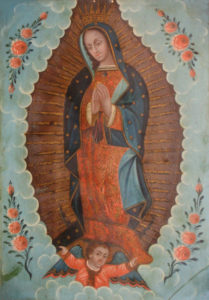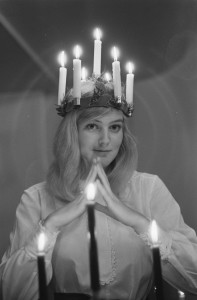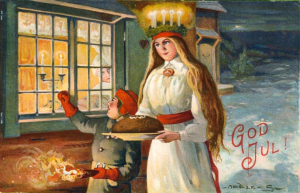I’ve told this story before, but I like it, so I’ll tell it again, especially since it is the 12th of December: the Feast of Our Lady of Guadalupe. She is sacred to Latin America and especially to Mexico, and her iconic image is one we know well, especially in places like Lake Worth, where there is a strong Latin American influence. Here’s the first part of the story, which is the bigger world story: it begins in 1531 with Juan Diego, who was just a regular guy in Mexico. He saw an apparition of a woman on a hill near Mexico City, and she asked him to build a church in her honor there on the hill. She spoke to him in his native Nahuatl language and he recognized her, by the things she told him, as the Virgin Mary.
The image we know so well, even to this day, miraculously appeared inside Juan Diego’s cloak in December, 1531: on one of his visits to the hill, Mary told Juan Diego to go to the barren top of the hill, but when he got there, he found it not at all barren but awash with blooming Castilian roses. He and Mary gathered the roses and she arranged them inside his cloak. And on this, her feast day, Juan Diego opened his cloak before the bishop of Mexico City. When he did, the flowers all fell to the floor, revealing the image of the Virgin of Guadalupe, this same iconic image we all know so well. The church was built, and the image from Juan Diego’s cloak, or tilma, hangs still inside the Basilica of Our Lady of Guadalupe on Tepeyac Hill, Mexico City.
So that’s the first part of the story. The second part of the story is more personal. It is rare that we hold a memory of precisely what we were doing on any given day in our history, but I know exactly what I was doing on December 12, 2000. It was our first December in our little old home in Lake Worth, and Seth and I were at the table eating dinner when suddenly we heard the sound of fireworks exploding above us. We both dropped our forks and ran out the back door to look into the night sky and sure enough there were fireworks exploding in the sky to the south of our house, toward Downtown Lake Worth. Since this town we love has a large Mexican and Mayan population, and since it was the 12th of December, we decided there was only one explanation for the fireworks: there was a big festival going on downtown for the Feast Day of Our Lady of Guadalupe! We couldn’t contain our excitement. We didn’t even bother to clean up or finish dinner but instead hopped into the truck and headed downtown for the festivities. We drove to Bryant Park on the lagoon, but it was silent, and so were the grounds of Sacred Heart Church as well as the plaza off the City Hall Annex and none of the downtown streets were blocked off, either, for this wonderful festival that we had concocted in our own minds.
I had left the house that night all excited for the singing and dancing and for the food but also to run into the street vendor who would be selling the traditional painted tin ornaments from Mexico that I’d been longing for… but of course there was no festival and there were no ornaments. Nothing. The fireworks probably came from one very enthusiastic celebrant at a private home. So we drove back home, awash in disappointment (and I’m sure Seth was wondering who else but us would hear fireworks and come to this same conclusion).
But that night, with all its excitement and disappointment, was a seed that eventually bloomed into what we do now, for I decided that if I couldn’t find the traditional painted tin ornaments I wanted locally, I’d go out and find them where they came from. And that maybe other folks would want them, too. And so that Feast of Our Lady of Guadalupe on the 12th of December at the tail end of the last century had a big effect on bringing you the Convivio Book of Days Catalog, where we sell traditional handicrafts pertaining to the seasonal round of the year, which evolved eventually into this blog and, hopefully, into the next logical step: a real book called The Convivio Book of Days that you can pull off your bookshelf to confer with when you wish, like an old friend. That’s the goal. Perhaps Our Lady of Guadalupe should be my patroness, too.
Image: A retablo depicting Our Lady of Guadalupe, painted by an anonymous artist in Mexico. Oil on tin, 19th century [Public domain] via Wikimedia Commons. Tomorrow, our attentions shift toward Italy and Scandinavia, but especially to Sweden, where in the dark hours of early morning young girls will don candle-lit wreaths on their heads, delivering saffron buns and coffee through the home. If you have a Swedish bakery nearby, today or tomorrow would be a fine day to stop by and pick up these golden S-shaped rolls. Here in the Lake Worth area, Polar Bakery is the place; they’re in the plaza at the northwest corner of Lantana Road and Congress Avenue in Lantana.


